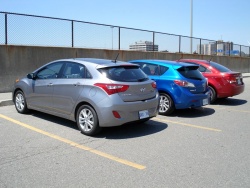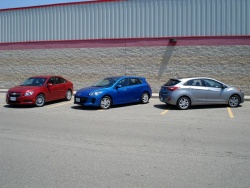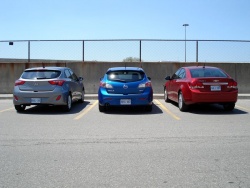 Hyundai Elantra GT GLS, Mazda3 GS-Sky, Chevrolet Cruze Eco. Click image to enlarge |
| Comparison Test: Compact cars |
By Mike Schlee
Photos by Mike Schlee and Jonathan Yarkony
Photo Gallery:
Compact cars, version 2.0
In the spring we performed a mammoth nine-vehicle Compact Car Comparison Test. In that field of vehicles, the 2012 Chevrolet Cruze LT Turbo squeaked out a narrow victory over the 2012 Mazda3 GS-Sky. As can be expected, debates got pretty heated in our online Autos.ca forum as to why other vehicles should have won, didn’t win, and why did our test not include X car equipped with Y trim. Once the dust settled, we landed on the notion that a rematch between the Mazda3 and Chevrolet Cruze was needed, but not until a new player came along to vie for the crown. Cue the 2013 Hyundai Elantra GT.
New for 2013, the Elantra family has grown to include two new models: a coupe and a hatchback. Dubbed the GT, the hatchback Elantra features new dampers front and rear as well as a revised suspension underneath the new 5-door body. Stuffed full of the most content in this group, the as-tested price for our GLS model rang in at $22,944—middle of the pack. In fact, the field of three vehicles here was separated by a mere $405 after destination fees.
  Hyundai Elantra GT GLS, Mazda3 GS-Sky, Chevrolet Cruze Eco. Click image to enlarge |
Taking on the new Elantra GT GLS was our returning champion, the Chevrolet Cruze. For this test however, we wanted to focus more on fuel mileage and economy. A Consumer Reports study found that 37 percent of those surveyed put fuel economy as the top priority for their next vehicle purchase. That is more than twice the next top consideration, which was quality, at 17 percent. With that in mind, we brought along the 2012 Chevrolet Cruze Eco, a fuel-efficient trim package that reduces weight, rolling resistance and adds a few trick features all in the name of parsimonious fuel consumption.
Rounding out this grouping of three was the 2012 Mazda3 Sport GS-Sky. Normally we would not invite back a vehicle that lost in a previous comparison test, but the results were so close between the Mazda3 and Cruze last time around that it was hard not include it again — especially in a comparison test emphasizing fuel economy. Of the nine vehicles tested in our last compact comparison test, the Mazda3 blew the competition away with a highly efficient 7.2 L/100 km during our testing period.
It is important to note one fuel efficient compact vehicle that is missing from this test, the Volkswagen Golf TDI. To take home a TDI Golf with similar options to the vehicles tested here would run the sticker price up to $27,695. After delivery charges, that would put it $4,600 to $5,000 more than the rest of the competition. Besides, we have a better comparison test slated for this fuel-sipping Golf later this summer.
To make things a little different this time, and to maximize efficiency, all three cars were equipped with 6-speed manuals; yeah, those three-pedal thingys. The funny thing is, after days of tests, deliberating, scoring, and totaling up the scores, the results were nearly a wash. On our 290-point rating system, the three vehicles were separated by 1 point each, finishing with 230, 229, and 228. What does that mean? Well, any of these three vehicles would make a great vehicle purchase, but for very different reasons, and the compact car segment has never been better or more closely contested. So, without further ado, read on to see how they placed.
3rd Place – 2012 Chevrolet Cruze Eco
    Chevrolet Cruze Eco. Click image to enlarge |
From first to worst may seem a little harsh for this little Chevrolet, but as was just mentioned in the intro, the margin of victory from first to worst was only 2 points. If the Cruze had a sunroof, or a hatchback option in Canada, or was a little more efficient, it could have taken this challenge. As it stands, the Eco Cruze is a very attractive vehicle that is, however, lacking in a few areas.
First and foremost are the Cruze’s interior, and options list. Both were viewed as worst in the comparison. Aside from the fabric patches on the dash, the Cruze’s interior is mostly hard-touch plastics with a strangely positioned uncomfortable front seat. This was the only vehicle of the group lacking a sunroof and lost points in cargo space since the North American market is not offered a five-door hatchback version of the Cruze. While we are on the topic of the trunk, since Chevy vetoed the spare tire on the Eco editions to save weight, an oddly contoured pit is left in the trunk floor. Sure it increases cargo volume to 436 L, but it makes for an awkward loading surface. As senior Editor Jonathan Yarkony stated “I don’t like the (Cruze’s) well… better if it converted to a flat floor.”
Where the Cruze did shine, though was in the chassis and drivetrain departments. This was the quietest vehicle of the group and the 1.4L turbocharged engine was the hands-down our favourite of the group. Although it is the smallest in displacement, makes the least horsepower, and has to carry around the most weight (1,366 kg), it was still the most responsive of the group. It was the only vehicle that could be left in sixth gear at highway speeds and perform passing maneuvers in a reasonable amount of time. All of this while having the lowest highway cruising rpms of the bunch: 1,900 rpm @ 100 km/h and 2,250 rpm @ 120 km/h.
The six-speed manual transmission is a great gearbox but not as precise and engaging as the Mazda’s unit. The Cruze Eco loses a lot of the handling hardware that made the Cruze RS such a fun car to drive in our earlier comparison test. That said, it still takes corners with confidence and is more fun to toss around than the Elantra GT. The 215/55R17 are the largest and widest tires of the group, but drew mixed reviews from the test group as to whether the painted chrome treatment on them looked tacky or classy.
When it came to efficiency the Cruze couldn’t live up to its official Natural Resources Canada fuel rating numbers of 7.2 L/100 km city and 4.6 L/100 km highway. We averaged a not very impressive 8.4 L/100 km in mostly city conditions which still put the Cruze mid-pack in this trio.
Pricing: 2012 Chevrolet Cruze Eco
Base price: $20,160
Options: Connectivity Package ($495), Premium Paint ($380)
A/C tax: $100
Freight: $1,495
Price as tested: $22,630
2nd Place – 2012 Mazda3 Sport GS-Sky
    2012 Mazda3 Sport GS-Sky. Click image to enlarge |
Always a bridesmaid, never a bride. That is how the Mazda3 GS-Sky must feel right now. For the second straight compact comparison test the Mazda3 has finished second; and again by just one point. Why? Well, it is the subtle nuances that have kept the Mazda3 from winning one of these comparison tests. The 3 has the worst rear seat entry angle, wheels that look out of date and a ride that some found to be too harsh for this vehicle segment.
The interior drew mixed reviews as to whether it was functional and modern, or cheap and drab. The materials used inside are a mix of soft and hard touch materials but the fit and finish seemed the worst in the group. Yes, a Japanese car has been out-qualitied by a Korean and American one; welcome to 2012. The stereo, on the other hand, sounds great and the front seats offer as much comfort as the Elantra GT’s.
The Hyundai and Mazda take two different approaches with the back half of their vehicles The Mazda3 offers less rear seat legroom, but more cargo depth than the Elantra GT. However, despite this, the Mazda3 was still rated as the most comfortable rear seat for both 2 or 3 full-grown passengers, thanks to a wider cabin.
On the road the Mazda3 is the sports car of the group. The shifter, handling, and steering feel were unmatched by the other two in this comparison. The trade-off for this handling prowess is the afore-mentioned rough ride, but NVH and suspension clunks are kept to a minimum. Even with 205/55R16 tires, the Mazda grips the corners beyond what you’d expect considering its efficient persona, giving you a vehicle with a dual purpose.
At the core of the Mazda3 GS-SkyActiv is the 2.0L four-cylinder engine. Featuring the most engine displacement of the group, and making the most power, 155 hp, the Mazda3 should be the drag strip champion as it weighs in at only 1,318 kg. However it did not feel this way. It always feels a little short on power, much like the Elantra GT. If the 2.0L engine is really wrung out in the higher rpms, power is there for the taking. But running around at 5,000 rpm defeats the real purpose of this vehicle, efficiency.
Here, the Mazda3 excels. It slaughtered the other two by averaging 7.3 L/100 km during our mostly city testing loops. In fact, it was the only vehicle to not only come close to its official NRCan fuel economy numbers but actually land between them: 7.6 L/100 km city and 5.1 L/100 km highway. But in the end, the Mazda3 just couldn’t match up to the Elantra GT as an overall package. If fuel mileage is your number one concern, however, stop reading now; this Mazda is your vehicle.
Pricing: 2012 Mazda3 GS-SkyActiv
Base price: $20,345
Options: Moonroof ($895)
A/C tax: $100
Freight: $1,695
Price as tested: $23,035
1st Place – 2013 Hyundai Elantra GT GLS
   2013 Hyundai Elantra GT GLS. Click image to enlarge |
As the famous saying goes, “the best laid plans go oft awry.” [Actually, they “gang aft agley”, but nobody’s much interested in arcane Scottish dialect these days, are they? –Ed.] We assembled a comparison test where fuel economy was a main focus, and the vehicle that achieved the lowest fuel economy ends up winning. How did that happen? Well, the new Elantra GT is just that good; but more on that latter. Let’s look deeper into the fuel economy issue.
This is our third comparison test involving a Hyundai vehicle and for the third straight time, we achieved dismal fuel economy. Although rated officially at 7.2 L/100 km in the city and 4.9 L/100 km on the highway, all we could achieve after our mostly city testing was a somewhat thirsty 8.8 L/100 km. This isn’t a dedicated efficiency model like the other two in this comparison test, but the NRCan ratings have the Elantra on par with the Cruze Eco and more efficient than the Mazda3 GS-Sky. It seems this car has been geared perfectly for the fuel mileage tests, where it becomes an overachiever. Part of the reason for the poor fuel economy result could be blamed on the highway cruising speeds of 2,400 rpm at 100 km/h and 2,850 rpm at 120 km/h. But then again, these are only 100 rpm higher than the Mazda3 GS-Sky.
But enough about efficiency; what earned the Elantra GT the win? Well, in short, everything else. The GT was stuffed with features not found in the other two cars, like a two-panel glass sunroof, adjustable effort steering control, fog lights, under floor rear hatch storage bins and a power driver’s seat. On top of that, nothing else was missing from the Elantra GT and it featured the usual power everything, Bluetooth connectivity, and telescopic steering. The front seats were comfortable and the interior featured a sharp design with a mix of soft and hard plastics.
On the road the Elantra GT felt planted and stable in all situations. It was not as engaging as the Mazda3 Sport, but felt easier to drive and more confidence-inspiring for novice drivers. All 2013 Hyundai Elanatra GTs get premium Sachs dampers front and rear compared and slightly revised suspension tuning compared to the Elantra sedan. This adds up to a much improved ride that has almost completely eliminated the sideways wiggle that offset bumps in the road induce in other Hyundai models. The suspension is not as soft as the Cruze’s, but not as firm as the Mazda3’s. There is a lot of audible suspension clump over bumps and there were a few surprising squeaks and rattles in the cabin. We think they were caused by the hard, rear cargo cover and the dual pane-glass roof.
The transmission was easy to use but lacked some of the precision of the other two gearboxes. The 1.8L 148-hp engine featured some good initial grunt off the line, but would then start to fall flat as the rpms rose. All in all though, they were both solid units. And that basically sums up this car. It is a solid offering that may not excel at any one aspect, but does everything very well. Add in a huge assortment of features and amenities at a price matching its rivals and it is a tough package to beat, as is proven by its first place finish. So for now, the Elantra GT can bask in the glory of being the Compact Car Champ and wait for the next challenge that should include the new Dodge Dart, the new Nissan Sentra, and maybe a surprise or two.
Pricing: 2012 Hyundai Elantra GT GLS
Base price: $21,349
Options: None
A/C tax: $100
Freight: $1,495
Price as tested: $22,944











